
David HillResearchGate, ORCID, ResearchID PhD Chemistry, UNC Chapel Hill, 2018 The College of William and Mary, B.S. Chemistry 2013 |

|
First Author


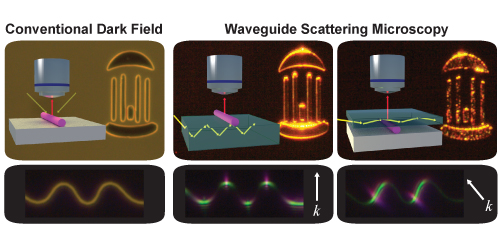
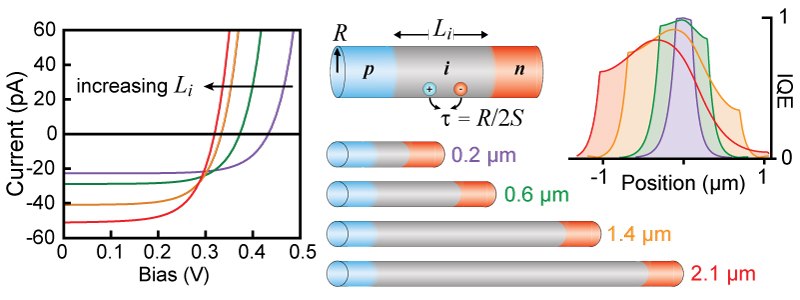
ACS Nano
Nanowires (NWs) with axial p-i-n junctions have been widely explored as microscopic diodes for optoelectronic and solar energy applications, and their performance is strongly influenced by charge recombination at the surface. We delineate how the photovoltaic performance of these diodes is dictated not simply by the surface, however, but also by the complex and seemingly counterintuitive interplay of diode geometry—i.e. radius (R) and intrinsic length (Li)—with the surface recombination velocity (S). An analytical model to describe these relationships is developed and compared to finite-element simulations, which verify the accuracy and limitations of the model. The dependence of the dark saturation current (Io), internal quantum efficiency (IQE), short-circuit current (ISC), and open-circuit voltage (VOC) on both geometric and recombination parameters demonstrates that no single set of parameters produces optimal performance; instead, various tradeoffs in performance are observed. For instance, longer Li might be expected to produce higher ISC, yet at high values of S the ISC declines because of decreases in IQE. Moreover, longer Li produces a concurrent decline in VOC regardless of S due to increases in Io. We also find that ISC and VOC trends are radius-independent, yet Io is directly proportional to R, causing NWs with smaller R to display higher turn-on voltages. The analysis regarding the interplay of these parameters, verified by experimental measurements with various p-i-n geometries and surface treatments, provides clear guidance for the rational design of performance metrics for photodiode and photovoltaic devices.

ACS Applied Materials and Interfaces
Although silicon (Si) nanowires (NWs) grown by a vapor–liquid–solid (VLS) mechanism have been demonstrated for a range of photonic, electronic, and solar-energy applications, continued progress with these NW-based technologies requires increasingly precise compositional and morphological control of the growth process. However, VLS growth typically encounters problems such as nonselective deposition on sidewalls, inadvertent kinking, unintentional or inhomogeneous doping, and catalyst-induced compositional gradients. Here, we overcome several of these difficulties and report the synthesis of uniform, linear, and degenerately doped Si NW superlattices with abrupt transitions between p-type, intrinsic, and n-type segments. The synthesis of these structures is enabled by in situ chlorination of the NW surface with hydrochloric acid (HCl) at temperatures ranging from 500 to 700 °C, yielding uniform NWs with minimal nonselective growth. Surprisingly, we find the boron (B) doping level in p-type segments to be at least 1 order of magnitude above the solid solubility limit, an effect that we attribute to a high incorporation of B in the liquid catalyst and kinetic trapping of B during crystallization at the liquid–solid interface to yield a highly nonequilibrium concentration. For growth at 510 °C, four-point-probe measurements yield active doping levels of at least 4.5 × 10^19 cm–3, which is comparable to the phosphorus (P) doping level of n-type segments. Because the B and P dopants are in sufficiently high concentrations for the Si to be degenerately doped, both segments inhibit the etching of Si in aqueous potassium hydroxide (KOH) solution. Moreover, we find that the dopant transitions are abrupt, facilitating nanoscale morphological control in both B- and P-doped segments through selective KOH etching of the NW with a spatial resolution of ∼10 nm. The results presented herein enable the growth of complex, degenerately doped p–n junction nanostructures that can be explored for a variety of advanced applications, such as Esaki diodes, multijunction solar cells, and tunneling field-effect transistors.
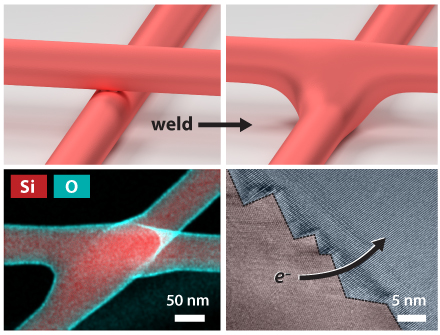
Nano Letters
Semiconductor nanowires (NWs) have been demonstrated as a potential platform for a wide-range of technologies, yet a method to interconnect functionally encoded NWs has remained a challenge. Here, we report a simple capillarity-driven and self-limited welding process that forms mechanically robust and Ohmic inter-NW connections. The process occurs at the point-of-contact between two NWs at temperatures 400–600 °C below the bulk melting point of the semiconductor. It can be explained by capillarity-driven surface diffusion, inducing a localized geometrical rearrangement that reduces spatial curvature. The resulting weld comprises two fused NWs separated by a single, Ohmic grain boundary. We expect the welding mechanism to be generic for all types of NWs and to enable the development of complex interconnected networks for neuromorphic computation, battery and solar cell electrodes, and bioelectronic scaffolds.

Dark-field microscopy (DFM) is widely used to optically image and spectroscopically analyze nanoscale objects. In a typical DFM configuration, a sample is illuminated at oblique angles and an objective lens collects light scattered by the sample at a range of lower angles. Here, we develop waveguide scattering microscopy (WSM) as an alternative technique to image and analyze photonic nanostructures. WSM uses an incoherent white-light source coupled to a dielectric slab waveguide to generate an evanescent field that illuminates objects located within several hundred nanometers of the waveguide surface. Using standard microscope slides or coverslips as the waveguide, we demonstrate high-contrast dark-field imaging of nanophotonic and plasmonic structures such as Si nanowires, Au nanorods, and Ag nanoholes. Scattering spectra collected in the WSM configuration show excellent signal-to-noise with minimal background signal compared to conventional DFM. In addition, the polarization of the incident field is controlled by the direction of the propagating wave, providing a straightforward route to excite specific optical modes in anisotropic nanostructures by selecting the appropriate input wavevector. Considering the facile integration of WSM with standard microscopy equipment, we anticipate it will become a versatile tool for characterizing photonic nanostructures.
Contributing Author






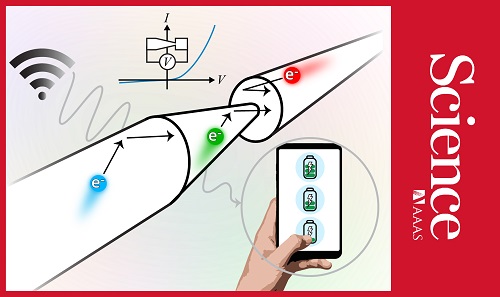
Science
Ratcheting effects play an important role in systems ranging from mechanical socket wrenches to biological motor proteins. The underlying principle is to convert a fluctuating, unbiased force into unidirectional motion. Here, we report the ratcheting of electrons at room temperature using a semiconductor nanowire with precisely engineered asymmetry. Modulation of the nanowire diameter creates a cylindrical sawtooth geometry with broken inversion symmetry on a nanometer-length scale. In a two-terminal device, this structure responded as a three-dimensional geometric diode that funnels electrons preferentially in one direction through specular reflection of quasi-ballistic electrons at the nanowire surface. The ratcheting effect causes charge rectification at frequencies exceeding 40 gigahertz, demonstrating the potential for applications such as high-speed data processing and long-wavelength energy harvesting.
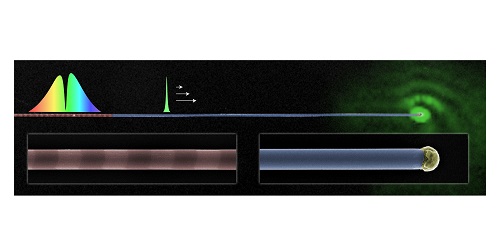
Nature Communications
All-optical operation holds promise as the future of computing technology, and key components include miniaturized waveguides (WGs) and couplers that control narrow bandwidths. Nanowires (NWs) offer an ideal platform for nanoscale WGs, but their utility has been limited by the lack of a comprehensive coupling scheme with band selectivity. Here, we introduce a NW geometric superlattice (GSL) that allows narrow-band guiding in Si NWs through coupling of a Mie resonance with a bound-guided state (BGS). Periodic diameter modulation creates a Mie-BGS-coupled excitation that manifests as a scattering dark state with a pronounced scattering dip in the Mie resonance. The frequency of the coupled mode, tunable from the visible to near-infrared, is determined by the pitch of the GSL. Using a combined GSL-WG system, we demonstrate spectrally selective guiding and optical switching and sensing at telecommunication wavelengths, highlighting the potential to use NW GSLs for the design of on-chip optical components.
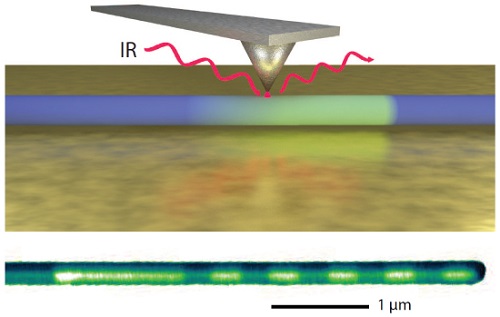
Nano Letters
We report the use of infrared (IR) scattering-type scanning near-field optical microscopy (s-SNOM) as a nondestructive method to map free-carriers in axially modulation-doped silicon nanowires (SiNWs) with nanoscale spatial resolution. Using this technique, we can detect local changes in the electrically active doping concentration based on the infrared free-carrier response in SiNWs grown using the vapor–liquid–solid (VLS) method. We demonstrate that IR s-SNOM is sensitive to both p-type and n-type free-carriers for carrier densities above ∼1 × 1019 cm–3. We also resolve subtle changes in local conductivity properties, which can be correlated with growth conditions and surface effects. The use of s-SNOM is especially valuable in low mobility materials such as boron-doped p-type SiNWs, where optimization of growth has been difficult to achieve due to the lack of information on dopant distribution and junction properties. s-SNOM can be widely employed for the nondestructive characterization of nanostructured material synthesis and local electronic properties without the need for contacts or inert atmosphere.

Nano Letters
Lead halide perovskites (LHPs) have shown remarkable promise for use in photovoltaics, photodetectors, light-emitting diodes, and lasers. Although solution-processed polycrystalline films are the most widely studied morphology, LHP nanowires (NWs) grown by vapor-phase processes offer the potential for precise control over crystallinity, phase, composition, and morphology. Here, we report the first demonstration of self-catalyzed vapor–liquid–solid (VLS) growth of lead halide (PbX2; X = Cl, Br, or I) NWs and conversion to LHP. We present a kinetic model of the PbX2 NW growth process in which a liquid Pb catalyst is supersaturated with halogen X through vapor-phase incorporation of both Pb and X, inducing growth of a NW. For PbI2, we show that the NWs are single-crystalline, oriented in the ⟨1̅21̅0⟩ direction, and composed of a stoichiometric PbI2 shaft with a spherical Pb tip. Low-temperature vapor-phase intercalation of methylammonium iodide converts the NWs to methylammonium lead iodide (MAPbI3) perovskite while maintaining the NW morphology. Single-NW experiments comparing measured extinction spectra with optical simulations show that the NWs exhibit a strong optical antenna effect, leading to substantially enhanced scattering efficiencies and to absorption efficiencies that can be more than twice that of thin films of the same thickness. Further development of the self-catalyzed VLS mechanism for lead halide and perovskite NWs should enable the rational design of nanostructures for various optoelectronic technologies, including potentially unique applications such as hot-carrier solar cells.
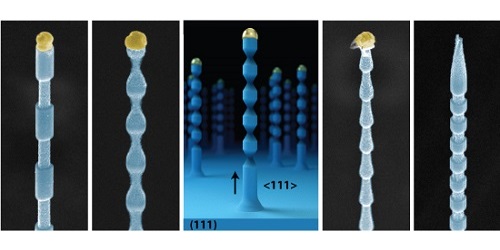
ACS Nano
Vertically aligned semiconductor nanowires (NWs) have many potential applications for NW-based technologies, ranging from solar cells to intracellular sensors. Aligned NWs can be fabricated by top-down etching of planar wafers or synthesized from the bottom up using the vapor–liquid–solid (VLS) mechanism to induce epitaxial growth on lattice-matched substrates. The VLS process permits the modulation of dopants along the NW growth axis, which if combined with dopant-dependent wet-chemical etching, can be used to encode precise morphology. However, the synthesis of vertical and linear NWs with complex morphology is nontrivial, requiring control over multiple interdependent aspects of the VLS process. Here, we demonstrate sub-10 nm morphology in ⟨111⟩ epitaxial silicon (Si) NWs grown by the VLS mechanism on (111) Si substrates with gold (Au) catalysts. Using silane (SiH4), phosphine (PH3), and hydrochloric acid (HCl) precursor gases at 480 °C, precise morphology is encoded through abrupt phosphorus (P) dopant transitions, which are found to be less than 5 nm in width. The results highlight three mechanistic attributes of the process. First, NW growth in the ⟨111⟩ direction is found to be unstable at high SiH4 partial pressures and growth rates unless using HCl, which stabilizes NW growth through chlorination of the NW sidewall. Second, aggregated Au deposited on the NW surface by the VLS catalyst is found to be immobile on the chlorinated surface and to impede selective wet-chemical etching by potassium hydroxide (KOH) solution, preventing the design of precise morphology. Third, the aggregation of Au is found to be strongly dependent on the SiH4 partial pressure and NW growth rate, and values exceeding ∼100 mTorr and ∼150 nm/min, respectively, are required to minimize Au and thereby enable selective wet-chemical etching. Under optimized growth conditions, we find that abrupt, complex, and arbitrary dopant profiles and morphologies can be encoded in vertical Si NWs, and we expect that a variety of electronic and photonic applications can be realized with these designed nanostructures.
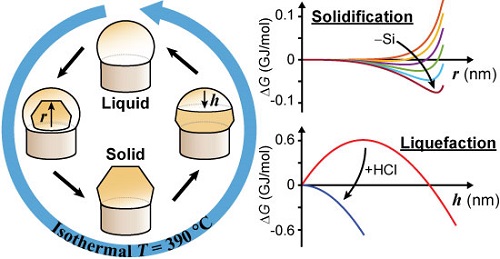
ACS Journal of Physical Chemistry Letters
Knowledge of nucleation and growth mechanisms is essential for the synthesis of nanomaterials, such as semiconductor nanowires, with shapes and compositions precisely engineered for technological applications. Nanowires are conventionally grown by the seemingly well-understood vapor–liquid–solid mechanism, which uses a liquid alloy as the catalyst for growth. However, we show that it is possible to instantaneously and reversibly switch the phase of the catalyst between a liquid and superheated solid state under isothermal conditions above the eutectic temperature. The solid catalyst induces a vapor–solid–solid growth mechanism, which provides atomic-level control of dopant atoms in the nanowire. The switching effect cannot be predicted from equilibrium phase diagrams but can be explained by the dominant role of the catalyst surface in modulating the kinetics and thermodynamics of phase behavior. The effect should be general to metal-catalyzed nanowire growth and highlights the unexpected yet technologically relevant nonequilibrium effects that can emerge in the growth of nanoscale systems.

Nano Letters
Mesoporous metal oxide film electrodes consisting of derivatized 5.5 μm thick SnO2 films with an outer 4.3 nm shell of TiO2 added by atomic layer deposition (ALD) have been investigated to explore unbiased water splitting on p, n, and p+n type silicon substrates. Modified electrodes were derivatized by addition of the water oxidation catalyst, [Ru(bda)(4-O(CH2)3PO3H2)-pyr)2], 1, (pyr = pyridine; bda = 2,2′-bipyridine-6,6′-dicarboxylate), and chromophore, [Ru(4,4′-PO3H2-bpy) (bpy)2]2+, RuP2+, (bpy = 2,2′-bipyridine), which form 2:1 RuP2+/1 assemblies on the surface. At pH 5.7 in 0.1 M acetate buffer, these electrodes with a fluorine-doped tin oxide (FTO) back contact under ∼1 sun illumination (100 mW/cm2; white light source) perform efficient water oxidation with a photocurrent of 1.5 mA/cm2 with an 88% Faradaic efficiency (FE) for O2 production at an applied bias of 600 mV versus RHE ( ACS Energy Lett., 2016, 1, 231−236). The SnO2/TiO2–chromophore–catalyst assembly was integrated with the Si electrodes by a thin layer of titanium followed by an amorphous TiO2 (Ti/a-TiO2) coating as an interconnect. In the integrated electrode, p+n-Si–Ti/a-TiO2–SnO2/TiO2|-2RuP2+/1, the p+n-Si junction provided about 350 mV in added potential to the half cell. In photolysis experiments at pH 5.7 in 0.1 M acetate buffer, bias-free photocurrents approaching 100 μA/cm2 were obtained for water splitting, 2H2O → 2H2 + O2. The FE for water oxidation was 79% with a hydrogen efficiency of ∼100% at the Pt cathode.
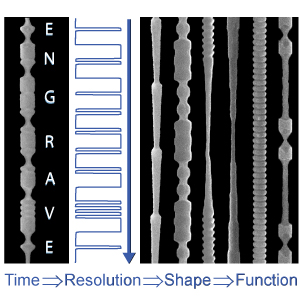
ACS Journal of Physical Chemistry Letters
The patterning of semiconductors with nanometer-scale precision is a cornerstone of modern technology. Top-down methods, ranging from photolithography to focused-ion beam milling, are typically used to fabricate complex nanostructures. In this Perspective, we discuss an alternative bottom-up method to encode similar high-resolution morphology in semiconductor nanowires (NWs). This process, termed ENGRAVE for “Encoded Nanowire GRowth and Appearance through VLS and Etching”, combines fast modulation of nanowire composition during vapor–liquid–solid (VLS) growth with composition-dependent wet-chemical etching. This method produces cylindrically symmetric structures in which the diameter is modulated on a sub-10 nm axial length scale. The process can produce patterns that range from periodic, centrosymmetric to nonperiodic, asymmetric structures, including gratings, fractals, tapers, ratchets, sinusoids, nanogaps, and nanodots. We discuss the prospect for the ENGRAVE process to become a complementary method of lithographic-like patterning that encodes unique morphologies and physical properties in semiconductors for a range of technologies.
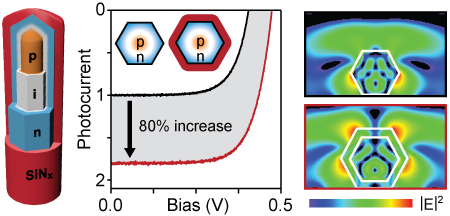
Semiconductor nanowires (NWs) often exhibit efficient, broadband light absorption despite their relatively small size. This characteristic originates from the subwavelength dimensions and high refractive indices of the NWs, which cause a light-trapping optical antenna effect. As a result, NWs could enable high-efficiency but low-cost solar cells using small volumes of expensive semiconductor material. Nevertheless, the extent to which the antenna effect can be leveraged in devices will largely determine the economic viability of NW-based solar cells. Here, we demonstrate a simple, low-cost, and scalable route to dramatically enhance the optical antenna effect in NW photovoltaic devices by coating the wires with conformal dielectric shells. Scattering and absorption measurements on Si NWs coated with shells of SiNx or SiOx exhibit a broadband enhancement of light absorption by ∼50–200% and light scattering by ∼200–1000%. The increased light–matter interaction leads to a ∼80% increase in short-circuit current density in Si photovoltaic devices under 1 sun illumination. Optical simulations reproduce the experimental results and indicate the dielectric–shell effect to be a general phenomenon for groups IV, II–VI, and III–V semiconductor NWs in both lateral and vertical orientations, providing a simple route to approximately double the efficiency of NW-based solar cells.